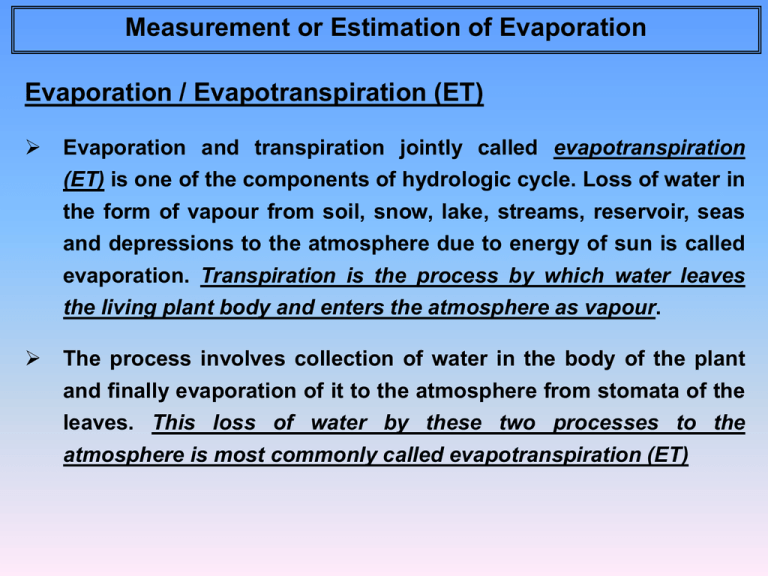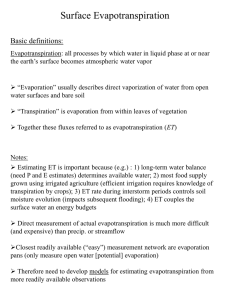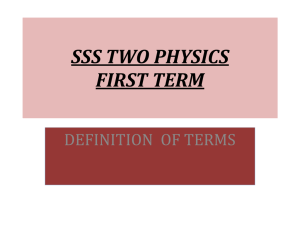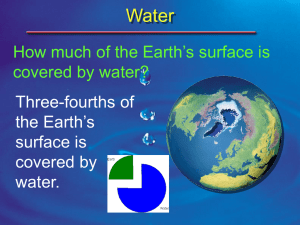Evaporation / Evapotranspiration
advertisement

Measurement or Estimation of Evaporation Evaporation / Evapotranspiration (ET) Evaporation and transpiration jointly called evapotranspiration (ET) is one of the components of hydrologic cycle. Loss of water in the form of vapour from soil, snow, lake, streams, reservoir, seas and depressions to the atmosphere due to energy of sun is called evaporation. Transpiration is the process by which water leaves the living plant body and enters the atmosphere as vapour. The process involves collection of water in the body of the plant and finally evaporation of it to the atmosphere from stomata of the leaves. This loss of water by these two processes to the atmosphere is most commonly called evapotranspiration (ET) Measurement or Estimation of Evaporation Factors Affecting Evaporation There are various factors like hydrological, meteorological and physical “that affect the rate of evaporation” from earth’s surface. They are discussed as follows; Radiation Radiation is the most important factor of evaporation. Solar radiation supplies continuous energy, which is essential for evaporation. “Evaporation is directly proportional to radiation”. Solar energy near the equator is more, therefore, evaporation is much more. Vapour pressure “Evaporation rate varies directly with difference of vapour pressure between air and water”. If E is the rate of evaporation (mm/day) and, ew and ea are the vapour pressure in water and in air, then E = C (ew – ea) ………………………. (1) Here C is constant, equation (1) is called “Dalton’s law”. Measurement or Estimation of Evaporation Factors Affecting Evaporation Temperature “Increase in air temperature increases evaporation” when other factors remaining same yet the high correlation coefficient between the two does not exit. In cold dry season although temperature is less, rate of evaporation is more because some of heat energy absorbed at lower depth in hot water is released in cold season. Wind velocity “The increase in wind velocity increases evaporation”. Wind removes the evaporated water vapour and thereby creates space for new evaporated water vapour. When there is no wind above the water body where the evaporated water vapour is in still condition, further evaporation ceases to take place. If wind velocity over the water body is high, it does not increases correspondingly the evaporation. “There is always a critical velocity of wind beyond which evaporation does not increase”. Measurement or Estimation of Evaporation Factors Affecting Evaporation Atmospheric Pressure If atmospheric pressure is more, according to “Dalton’s law”, ea is more, hence less evaporation. “Thus, decrease in atmospheric pressure can increase evaporation”. At higher altitude, atmospheric pressure is low; hence evaporation should have been more. But this is not necessary because temperature at higher altitude is low which reduces evaporation. Area of Water Surface “Evaporation is directly proportional to the area exposed”. Hence, if area is more, evaporation is more. Quality of water It also affects the rate of evaporation. “If water contains dissolved salts, it reduces the saturated vapour pressure es” and by Dalton’s law, E decreases. Also turbidity of water has some indirect effects. Measurement or Estimation of Evaporation Factors Affecting Evaporation Nature of Evaporating surface Evaporating surface is classified into three main surfaces; land surface, water surface and snow surface. Temperature remaining the same, evaporation from saturated soil surface is same to that of adjacent water surface. “Evaporation decreases when the soil surface is dry”. Thus, evaporation is dependent on the availability of water on the surface. Further, it is again dependent on presence or absence of vegetal cover. “Evaporation rate decreases in the following order; bare ground, grass and croplands, light forests and dense forest”. Salinity of Water It actually falls under quality of water. Yet if the soil is saline, evaporation decreases. Measurement or Estimation of Evaporation Factors Affecting Evaporation Depth of Water in the Water Body If the depth is more, it increases evaporation in winter season. On the other hand, low depth increases evaporation in summer as all water gets warmed up by solar radiation. Humidity “If humidity is more, water holding capacity of air is less, so less evaporation”. If water content is less in air, more evaporation will take place. Measurement or Estimation of Evaporation Measurement of Evaporation i) Empirical formulas Fitzgerald’s Equation Fitzgerald gave the following equation E = (0.4 + 0.124V) (es – ea) ………………………. (1) Where E is evaporation in mm/day, es is saturated vapour at the temperature of water surface in (mm), ea is actual vapour pressure of air in (mm) and V is average wind speed at the surface (km/hr). Meyer’s Equation E = C (1 + V/16) (es – ea) …………………………. (2) The values of E, V, es and ea are already defined with their magnitude and dimensions. Measurement or Estimation of Evaporation Measurement or Estimation of Evaporation Rohwer’s Equation Rohwer developed the following equation; E=0.771(1.456 – 0.000732Pa)(0.44 + 0.0733V)(es – ea)…(3) Horton’s Equation E = 0.4 (2 – e-0.124V)(es – ea) …………………….(4) the values of E, es, ea and V have the same significance as explained Lake Mead’s Equation E = 0.0331V(es – ea)[1 – 0.03(Ta – Tw)] ….……….… (5) Here Ta and Tw are average temperature in 0C of air and water surface respectively. Measurement or Estimation of Evaporation ii. Water Budget Method or Storage Equation Evaporation E from a reservoir or water body can be determined by the following water budget or storage equation E = P + I – O + Ou + ΔS …………………… (1) Where P is the total precipitation, I is total inflow, O is the total outflow, Ou is total underground inflow or outflow “which is positive for inflow and negative for outflow” and ΔS is change in storage (+ve for an increase in storage and –ve for decrease in storage). “All the parameters are converted into same units”, preferably in terms of depth of water area, for some convenient time interval. Measurement or Estimation of Evaporation iii. Energy Budget Method This method is based on the application “of the law of the conservation of Energy in the form of heat”. The energy budget equation from enclosed figure may be written as; Qi – Qr – Ql – Qc – Qe = Qs – Qa Qe = Qi – Qr – Ql – Qc – Qs + Qa Where Qi is short solar radiation, Qr is reflected part of solar every, Ql is long wave atmosphere radiation, Qc is conduction energy in air, Qe is heat energy used in evaporation, Qs is increase is stored energy and Qa is advective energy. To calculate Qc, Bowen ration (r) r = Qc / Qe Since Qe = pLE ………………….. (5.9) Where ‘p’ is the density of water, ‘L’ is the latent heat of evaporation and ‘E’ is evaporation in mm. Measurement or Estimation of Evaporation Thus, r = Qc/Qe = Qc/pLE Bowen ratio can again be expressed as r = Qc/Qe = [Qi – Qr – Ql – Qe – Qs + Qa] Qe or r = (Qi – Qr – Ql – Qs + Qa) – 1 Qe or (1 + r) = (Qi – Qr – Ql – Qs + Qa) Qe or (1 + r) = [Qi – Qr – Ql – Qs + Qa] pLE Therefore E = [Qi – Qr – Ql – Qs + Qa] pL(1 + r) i.e. Qe = pLE Measurement or Estimation of Evaporation When parameters are measured for short period, Qs and Qa (negligibly small) may be neglected. Then above Equation becomes; E= Qi – Q r – Ql pL(1 + r) ……………….. (a) Again E = (Qi – Qr – Ql) + (Qa – Qs) ……… (b) pL(1 + r) or E= Where Qin pL (1 + r) ……………… (c) Qin = Net solar radiation and r = 6.1 x 10-4 Pa [(Tw – Ta) ew – ea Measurement or Estimation of Evaporation Heat Energy Budget (Picture) Measurement or Estimation of Evaporation iv. Pan Measurement Methods A) US weather Bureau “Class A Pan (Surface Pan)” The US weather Bureau Class a Pan or surface pan evaporimeter along with its shown in the enclosed figure. It is made of galvanized iron sheet. It is painted white. The pan is kept in wooden platform as shown in the figure so that air can circulate freely. Evaporation is measured by a “hook gauge in a stilling well”. water level is measured daily. Water is added every day upto the fixed level. “A pan coefficient of 0.7 is taken and thus pan coefficient is”; Pan coefficient = 0.7 = Lake evaporation / Pan evaporation Measurement or Estimation of Evaporation Advantages It gives stable pan coefficient (0.6 to 0.8). The average value 0.7 is normally adopted without appreciable error. It is easy for observation i.e. measurement. It has relative freedom of dirt and trash. Cost of installation is reasonable low. Disadvantages The pan gives higher rate of evaporation than that of large free water surface. Effects of wind and radiation are more which overestimate the expiration rate. Measurement or Estimation of Evaporation Pan A (Picture) Measurement or Estimation of Evaporation B) ISI Standard Pan In the enclosed figure, “ISI standard pan has been sown”. It is also known as modified class A pan. Dimensions of the pan are shown in the figure. It is placed in the vicinity of the lake or reservoir to determine the evaporation of the lake. “It is covered with wire mesh of galvanized iron to protect the water in the pan from birds”. Pan is made of copper sheet of 0.9 mm thickness. The pan has a stilling well with a point gauge and thermometer. Amount of water lost can be measured by the point gauge. Water is added to bring it back to the original level. Readings are measured normally twice a day. “The annual pan coefficient is 0.7”. Measurement or Estimation of Evaporation Advantages As the pan is placed over wooden support, air circulation around the pan is alright. Allowance for rainfall can be made if required. Evaporation rates obtained are quite compatible to the rate of large water body. Disadvantages If screened at the top, interference of wind takes place and there by evaporation rate is reduced about 1.144 times as reported from experiment. If left unscreened, birds-bathing in the pan and drinking water from the pan may affect the evaporation. Measurement or Estimation of Evaporation Modified Pan A (Picture) Measurement or Estimation of Evaporation C) Colorado Sunken Pan: The Colorado Sunken Pan with its usual dimensions is shown in the enclosed figure. It is buried into the ground. Water level in the pan is at ground level. Advantages The advantage of this pan is that radiation and aerodynamics effects are similar to lake. Disadvantage It is difficult to detect leak, if any. Extra precaution is to be taken for the effect of surrounding tress in the area. Installation is expensive Measurement or Estimation of Evaporation Sunken Pan (Picture) Measurement or Estimation of Evaporation D) US Geological survey floating Pan To simulate the characteristics of large body of water, this floating pan is adopted. “It is square pan of 90 cm side and 45 cm depth”. It is supported by drum floats in the middle of the raft of size 4.25m x 4.87m. The water level in the pan is kept at the same level of the lake with rim of 7.5 cm. To prevent wave action of the lake, diagonal baffles are provided in the pan so that surging in the pan is reduced. Advantages The pan floats in take and environment for evaporation is same as that of the lake. Evaporation rates obtained is very close to lake evaporation. Disadvantage High cost of installation is there. Maintenance cost is also more. Measurement of evaporation is the main disadvantage. Measurement or Estimation of Evaporation Floating Pan A (Picture) Estimation of Evapotranspiration Pitche Evaporimeters or Atmometer Atmometer is another device to measure evaporation. Atmometers is provided with some special surfaces which is kept wet and from which water loss by evaporation is recorded. Pitche Atmometer or evaporimeter is a graduated glass tube of 1.5 cm in diameter and 30 cm long and one open end. It is filled with water and its open end is covered with a dry paper, held in position by metal clip. The tube is held in inverted position so that water wets the paper from which evaporation takes places. Water loss in the tube is recorded as a measure of evaporation. Atmometer is shown in (figure enclosed). Estimation of Evapotranspiration Picthe Evaporimeters or Atmometer Advantages i. It is easy to handle as the size is small and reading are obtained directly from graduated scale. ii. For quick and rough estimate, it is better. Disadvantages i. ii. iii. iv. v. vi. Atmometer does not provide good measurement. The readings obtained are more erratic them other standard pan. Because of its small size, rates of evaporation are in excess of the rates of other evaporimeters. Values are usually higher than those obtained by U.S. Weather Bureau Class ‘A’ pan. Readings tend to overestimate due to wind effects and underestimate due to radiation effects. Evaporating surface is often subject to contamination by dust and other foreign. Picthe Evaporimeters or Atmometer 26 Estimation of Evapotranspiration Methods to Reduce Reservoir Evaporation Evaporation from water body is a continuous process. Multipurpose projects are always with a big reservoir with bigger surface area, so loss due to evaporation is more. “Various methods to reduce reservoir evaporation are discussed as follows”; Reduction of Surface Area of Reservoir o Evaporation is directly proportional to water surface area of the reservoir. In selecting the site for reservoir, due consideration should be given for deep reservoir with less surface area. Reservoirs in deep gorges are preferable. Wind Breakers o Some has advocated for wind breakers as wind velocity over the surface increases the evaporation. If tall trees like Causerina are allowed to grow on windward side of the reservoir, it may act as natural wind breakers. Besides it may help in cooling the water surface obstructing solar radiation at least for a part of the day. Wind breakers are effective only in small reservoir. Estimation of Evapotranspiration Consumptive use (Cu) may be defined as the amount of water used in evapotranspiration from an area under vegetation plus the water used by the plants in their process for building up the plant tissues. The amount of water required in building up the metabolic process is quite insignificant compared to evapotranspiration and hence, evapotranspiration (ET) is practically equal to consumptive use (Cu). There are several methods of estimating (ET) or (Cu). The following are some of the methods; this Estimation of Evapotranspiration i) Empirical Equations Blaney-criddle Method Thornthwaite Equation Penman Equation Christiansen Equation ii) Field Measurement Methods Lysimeters Field Plots Soil-moisture Depletion Studies Water balance Method Evaporation index Method Estimation of Evapotranspiration Empirical Equations Blaney-criddle Method Cu = ET = ∑k p (4.61t + 81.3) 100 Where ‘C’ is in cm, ‘t’ is mean monthly temperature in C0, ‘k’ monthly consumptive use coefficient determined from experiment, ‘p’ is monthly percentage of hours sunshine. Penman Equation E = (ΔQin/Le) + (0.00061PEa) …………. (a) Δ + 0.00061P Δ is the slope of the saturated vapor pressure curve at air temperature in (mm). ‘0C’, From this calculated value of ‘E’, the potential Evapotranspiration (PET) is calculated as under; PET = KE Where E is given in (a) above and the value of ‘k’ depends types of crops. Estimation of Evapotranspiration Field Measurement Method Water Balanced Method Evapotranspiration (E) = [(Surface flow + Sub Surface Inflow + Imported Water)] – [(Surface outflow + Sub Surface outflow + Domestic, municipal and industrial use + Exported water + Increase in surface storage + Increase in ground water storage)] Evaporation Index Method a high degree correlation between consumptive use (ET) and evaporation (E) exist. Therefore, (ET) is express in terms of ‘E’ as under; ET = KE Where K is the coefficient giving the ratio of (ETIE) and was found to vary with the stage of growth of the crop. Calculation of Evaporation Water Budget Method 32 Estimation of Evapotranspiration Question-I A class-A pan was setup adjacent to a lake. The depth of water in the pan at beginning was 195 mm. in that week, a rainfall of 45 mm came and 15 mm of water was removed from pan to keep the water level in the specified depth. If the depth of water at end of the week was 190 mm, calculate pan evaporation. Using suitable pan coefficient, estimate lake evaporation in that week. Solution o Initial depth of water in the pan = 195 mm o After the rainfall, total water in the pan = (195+45-15) mm = 225mm o At the end of the week depth water in the pan is 190 mm o Evaporation from the pan in the week = (225 – 190) mm = 35 mm o Assume suitable pan coefficient is 0.7 o Evaporation from the lake in the week = (0.7 x 35) mm = 24.5 mm Estimation of Evapotranspiration Question-II A reservoir has average surface area of 20 km2. In the month of June, mean rate of inflow is 10 m3/sec. mean outflow is 15m3/sec, rainfall is 10 cm and change of storage is 16 million m3. assuming surface losses to be 1.8cm, Estimate the Evaporation. Solution As per water budget equation; Inflow + Precipitation = Outflow + Surface outflow + Change in storage + Evaporation Now, inflow = 10 m3/sec = 10 x 24 x 30 x 60 x 60 = 1.296 m 20 x 106 Precipitation = 10 cm = 0.1 m Outflow = 15 m3/ sec = 10 x 24 x 30 x 60 x 60 = 1.944 m 20 x 106 Estimation of Evapotranspiration Surface outflow = 1.8 cm = 0.018 m, Storage = 16 x 106 = 0.8 = -0.8 m 20 x 106 Storage =ve, since outflow > inflow Putting the value in the water budget equation 1.296 + 01 = 1.944 + 0.018 – 0.8 + E E = 1.296 + 0.1 + 0.8 – 1.944 – 0.018 = 0.234 m = 23.4 cm The evaporation in June is 23.4 cm Question-III The catchment area of an irrigation tank is 70 km2. The constant water spread during October 2006 was 2 km2. During that month, the uniform precipitation over the catchment was recorded to be 100 mm. 50% of the precipitation reaches the tank. The irrigation canal discharges at a uniform rate of 1.00 m3/ sec in the month of October. Assuming seepage losses to be 50% of the evaporation losses, find out the daily rate of evaporation for October 2006. Solution: Total Inflow Outflow from canal Loss of water = 70 x 106 x 100 x 0.5 = 3.50 x 106m3 1000 = 1 x 3600 x 24 x 31 = 2.68 x 106m3 = 3.50 x 106 – 2.68 x 106 = 0.82 x 106 m3 = Seepage Loss + evaporation loss Since seepage loss is 50% that of evaporation loss, Loss of water = 1.5 x evaporation loss Therefore, evaporation loss = 0.82 x 106 = 0.55 x 106 m3 1.5 Rate of evaporation = 0.55 x 106 x 1000 = 8.8 mm/day/m2 2 x 106 x 31 Question-IV The catchment area of a reservoir is 10.0 km2. A uniform precipitation of 0.5 cm/h for 2.0 h was observed on 7th of July. 50% of the runoff reached the reservoir. A canal carrying a discharge of 1.25m3/sec is taken from the reservoir. The rate of evaporation observed was 0.7 mm/m2/h. The seepage loss was observed to be 50% of the evaporation loss. Find the change in the reservoir level on 4th July from 8:00 a.m. to 6:00 p.m. if the water spread of the reservoir was 0.476 km2. Solution: Inflow into the reservoir Canal Outflow = 10.0 x 106 x 0.5 x 2.0 x 0.5 = 5.0 x 104m3 100 = 1.25 x 10 x 3600 = 4.5 x 104m3 Evaporation and seepage losses = 0.476 x 106 x 10 x 1 x 0.7 x1.5 1000 = 0.5 x 104m3 Total outflow from the reservoir = 4.5 x 104m3 + 0.5 x 104 = 5.0 x 104 x 104m3 = inflow Hence, there will not be any change in the reservoir water level. Calculation of Evaporation by Emperical Formula 38 VARIOUS TERMS 40 41 42 43 Water Requirement of Crops and Soil Water Relationship B) Empirical Methods i) Blaney – Criddle Method o Blaney and Criddle derived an equation of consumptive use (CU) of water. They initially derived the equation in FPS unit. When that initial empirical equation is converted to MKS unit, it is written as; CU = ∑ kp (4.61t + 81.3)/100 o Here CU is in cm/month, ‘t’ is mean monthly temperature in 0C, ‘k’ is monthly consumptive use coefficient determined from experimental data, ‘p’ is monthly percentage of hours bright sunshine, ∑refers the summation of all the months of the season. Thus if ‘t’, ‘p’, ‘k’ are given CU can be estimated. Water Requirement of Crops and Soil Water Relationship Example In a crop filed in Sahiwal in the month of November the percentage of sunshine hours is 7.2 and mean temperature is 180C. If the consumptive use coefficient of crop is assessed to be 0.7 for that month, find the consumptive use of the crop in mm/day by BlaneyCridle method. Solution Blaney-Cridle equation is CU = ∑ kp (4.61t + 81.3)/100 When CU in cm/month Here k = 0.7, p = 7.2 percent and t = 180C CU = 0.7 x 7.2 (4.61 x 18 + 81.3) 100 = 8.264592 cm/month = 0.2754864 cm/day







